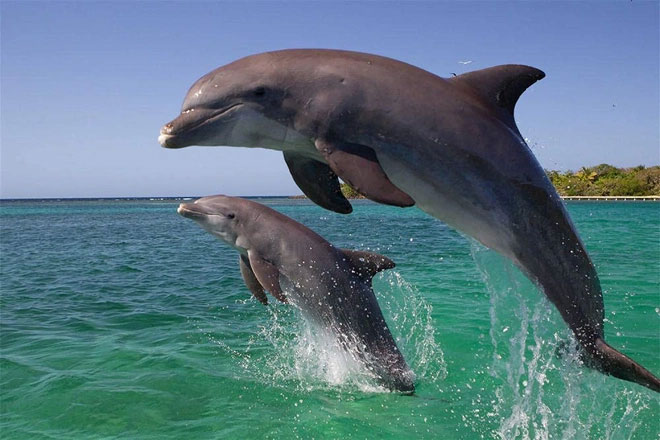Each pod of dolphins consists of smaller groups that function as caregivers, including mothers and their calves. Female dolphins even care for the young of other mothers.
The bottlenose dolphins are friendly and live in pods of up to 100 individuals. Intelligent and highly social, dolphins do everything together, including raising their young in caregiver groups. They use sound to communicate with one another. Each dolphin has its own unique whistle. This helps them recognize each other, locate one another, and provide assistance.

Dolphins are intelligent animals. (Photo: tourismwings).
Dolphins primarily eat small fish and squid. They use echolocation to find their prey, a technique known as sonar navigation. Dolphins leap out of the water to get a better view of their prey, and they can swim at speeds of up to 30 km/h (19 mph).
In terms of reproduction, male dolphins will wait for a female to swim into their area or actively seek a mate. The pair of dolphins will then swim side by side, rubbing bellies during mating. Female dolphins are pregnant for 12 months before giving birth.
The mother will teach the newborn calf to swim right beside her. As the mother swims, her body creates waves that help the calf glide through the water alongside her. At birth, the calf is pushed to the surface by the mother or another female in the pod so it can take its first breath. Like all mammals, dolphins have mammary glands and nurse their young with milk. Calves nurse while the mother is swimming, each feeding lasting 4-5 seconds.
Within each pod, there are smaller groups that serve as caregivers, including mothers and their calves. Female dolphins even care for the young of other mothers. This is known as “alloparenting.” Female dolphins form groups to protect the calves from predators such as sharks. Calves nurse until they are 2 years old and stay with their mothers for 3 to 6 years.
Cooperative parenting is also observed in sharks. After 10-12 months, when it’s time to give birth, female sharks will swim to the edge of the mangrove forest. This is the “nursery,” where their young will spend their early years. Shark pups are born near special “nursery” areas, such as coastal mangrove forests. Here, there are plenty of shelters and food sources to give the young the best chance of survival.


















































